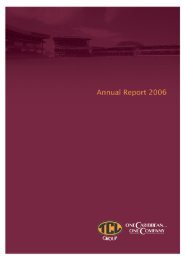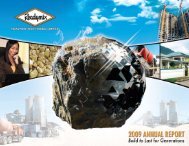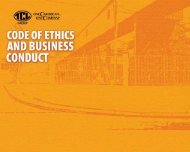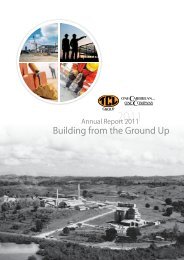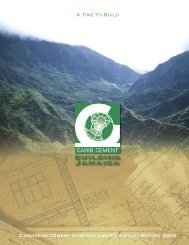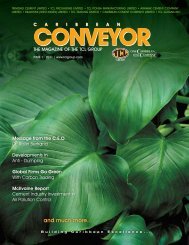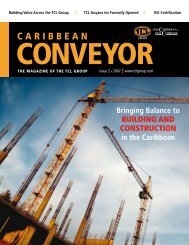Download File - TCL Group
Download File - TCL Group
Download File - TCL Group
You also want an ePaper? Increase the reach of your titles
YUMPU automatically turns print PDFs into web optimized ePapers that Google loves.
NOTES TO THE CONSOLIDATED FINANCIAL STATEMENTS<br />
FOR THE YEAR ENDED 31ST DECEMBER, 2010<br />
(Expressed in Thousands of Trinidad and Tobago Dollars, except where otherwise stated)<br />
(Continued)<br />
2. Significant accounting policies (continued)<br />
b) Basis of consolidation<br />
These consolidated financial statements comprise the financial statements of Readymix (West Indies) Limited (the “Parent”) and its<br />
subsidiaries. The financial statements of the subsidiaries are prepared for the same reporting period as the Parent, using consistent<br />
accounting policies. Subsidiary undertakings, being those companies in which the <strong>Group</strong>, directly or indirectly has an interest of more<br />
than one half of the voting rights, are fully consolidated from the date of acquisition, being the date on which the <strong>Group</strong> obtained<br />
control. All intercompany transactions, balances and unrealised surpluses and deficits on transactions between group companies are<br />
eliminated in full.<br />
Non-controlling interests represent the portion of profit or loss and net assets not held by the <strong>Group</strong> and are presented separately in the<br />
consolidated statement of income, comprehensive income and within equity in the consolidated statement of financial position.<br />
c) Significant accounting judgments, estimates and assumptions<br />
The preparation of the consolidated financial statements requires management to make judgments, estimates and assumptions that<br />
affect the reported amounts of revenues, expenses, assets and liabilities and the disclosure of contingent liabilities, at the reporting<br />
dates. However, uncertainty about these assumptions and estimates could result in outcomes that require a material adjustment to<br />
the carrying amount of the asset or liability affected in future periods. The key judgments, estimates and assumptions concerning<br />
the future and other key sources of estimation uncertainty at the reporting date, that have a significant risk of causing a material<br />
adjustment to the carrying amounts of assets and liabilities within the next financial year are discussed below:<br />
Deferred tax assets<br />
Deferred tax assets are recognized for all unused tax losses to the extent that it is probable that taxable profit will be available against<br />
which the losses can be utilized. Significant management judgment is required to determine the amount of deferred tax assets that can<br />
be recognized, based upon the likely timing and the level of future taxable profits together with future tax planning strategies.<br />
Pension benefits<br />
The cost of defined benefit pension plans as well as the present value of the pension obligation is determined using actuarial valuations.<br />
The actuarial valuation involves making judgments and assumptions in determining discount rates, expected rates of return on assets,<br />
future salary increases and future pension increases. Due to the long-term nature of these plans, such assumptions are subject to<br />
significant uncertainty. All assumptions are reviewed at the reporting date.<br />
Property, plant and equipment<br />
Management exercises judgment in determining whether cost incurred can accrue significant future economic benefits to the <strong>Group</strong><br />
to enable the value to be treated as a capital expense. Management also exercises judgment in the annual review of the useful lives of<br />
all categories of property, plant and equipment and the resulting depreciation charge determined thereon.<br />
Impairment of goodwill<br />
The <strong>Group</strong> determines whether goodwill is impaired at least on an annual basis. This requires an estimation of the ‘value-in-use’ of the<br />
cash generating units to which the goodwill is allocated. Estimating a value-in-use amount requires management to make an estimate<br />
of the expected future cash flows from the cash generating units and also to choose a suitable discount rate in order to calculate the<br />
present value of those cash flows. Further details are provided in Note 8.<br />
18<br />
BUILD TO LAST FOR GENERATIONS



